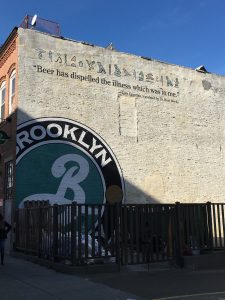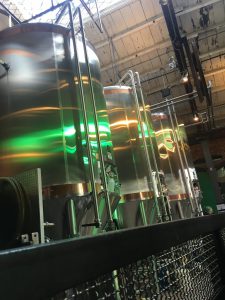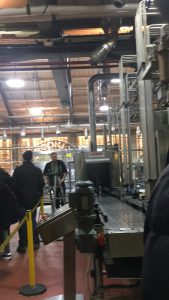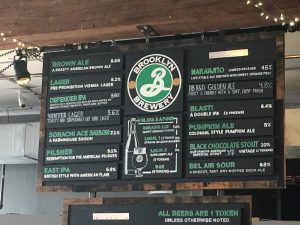Throughout this semester I have acquired a lot of knowledge about wine that I did not  have before, so for the beverage production assignment I wanted to take advantage of the alternative assignments and go to a brewery. On November 11th, I visited Brooklyn Brewery and attended a tour of the facility. During the tour, I learned a lot about the history of the business and how they make their product.
have before, so for the beverage production assignment I wanted to take advantage of the alternative assignments and go to a brewery. On November 11th, I visited Brooklyn Brewery and attended a tour of the facility. During the tour, I learned a lot about the history of the business and how they make their product.
The first topic covered during the tour was the four ingredients in beer. Beer is about 90-95% water and the rest is made of grains, yeast, and hops. It is believed that the vitamins and minerals in New York’s water are big factors in what makes their beer distinct. As for the grain, they mostly use malted barley for the beer. During the tour, we saw, touched and smelt two different kinds of malted barley, a pale ale malt and a chocolate malt. Each one smelt distinctly different which provides different qualities to the beer. There hops are grown from all over the U.S and depending on the type of flavor beer they are making, hops are acquired from different places. Currently, most of their hops come from Washington because of their seasonal beers currently on the menu.
When learning about the process and brewing practices used to make their beer, I learned there is a lot of science that goes into the process. The process starts by putting the grains in water for 48 hours. This is done to start extracting the sugars from the grain, which will eventually be eaten by the yeast to create carbon dioxide. After 48 hours, they remove the grain, dry it, and roast it to a specific color that will determine the type of beer they are making. Next, the dry grains are reintroduced to hot water in one of their automated machines to create the “mash”, which according to the tour guide, is a sticky paste. After the mash is formed, it is sent to another machine that separates the sugar liquid from the grain becoming unfermented beer, or wort. The final step before fermentation is adding their hops to the unfermented beer in a brew kettle. The hops are what gives the beer its spicy flavor and helps preserve the final product. For Brooklyn Brewery, hops only stay in the mix for a maximum of 90 minutes. After 90 minutes, the hops are separated from the beer. It is at this stage that there brew master, Jared Oliver, decides if it will be an ale or a lager. Lagers ferment longer and in colder temperatures while ales are the opposite. After fermentation, the product is finished and ready to be bottled.
As for bottling, there were a few practices and techniques I thought were interesting. When the beer is ready to be put in a keg, they force carbonate the liquid to speed the process along. Another interesting technique used is adding a small amount of hot water to their 12 oz. bottles to push out the oxygen in the bottle. According to the tour guide, this prevents it from oxidizing and going stale, which increases the quality and shelf life of their product. This is a technique only used for their 12 oz. bottles because oxidation isn’t a concern in the bigger bottles. There bigger bottles will continue to ferment. More sugar and yeast is added, then it is corked like a bottle of wine and left to ferment. This process gives the beer a completely different flavor from the same beer put into 12 oz. bottles.
For Brooklyn Brewery, it is not just how the beer is made that makes it special, but how the company got started. Owners Steve Hindy and Tom Potter started Brooklyn Brewery in 1988. Hindy learned to make craft beer from his journalism travels in the Middle East. After leaving the Middle East and bringing his family back to Brooklyn, he continued to make craft beer in his apartment where he met his business partner Tom Potter, a bank investor who lived downstairs. From that friendship and general appreciation of beer, Brooklyn Brewery was born. Together Hindy and Potter brought craft beer back to Brooklyn and, not even 30 years later it is has become the world’s number one craft beer exporter in the United States. It is also the 11th largest craft brewery in the U.S and has the world’s most recognizable craft beer logo, created by Milton Glasser.
After the tour, I walked around the tasting room which was a lot like the tour, loud yet relaxed. After waiting on line, I spoke to one of the attendants behind the counter. They were very knowledgeable and explained the items on the menu more. Considering my knowledge on beer is limited, I did not know what IPA was or what the beers on the menu tasted like. I was told IPA is a beer style that has a “hoppy flavor”. I only
understood what he meant because I smelt hops on the tour. Even though I did not buy anything the attendant still answered my questions and took the time to describe the different beers to me. I was surprised they were so willing to help considering the line was getting very long behind me.
Overall, this experience opened my mind up to different types of fermented beverages aside from wine and taught be a lot about the product. I am glad I got to learn more about beer and can now appreciate the beverage a little more.







The technical and cultural components of the tour seemed to help you accomplish your goal of learning more about beer.